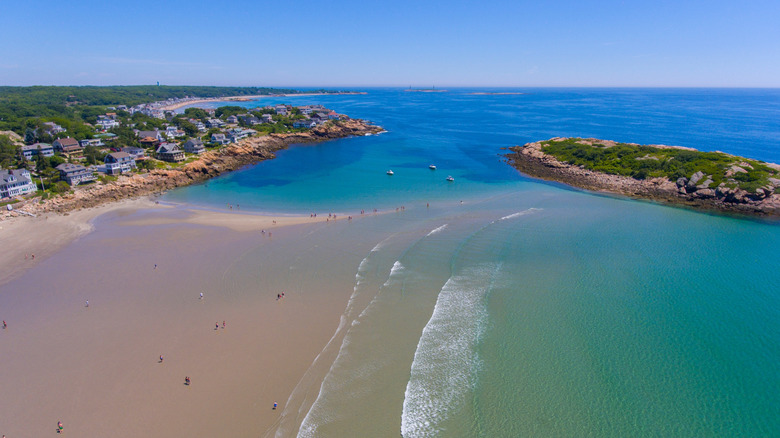We may receive a commission on purchases made from links.
Massachusetts boasts more than 1,500 miles of coastline with beaches ranging from rocky nooks and pebbled coves to wide expanses of soft sand and rolling dunes, but some are truly a cut above the rest. Good Harbor Beach in Gloucester, Massachusetts on Cape Ann is a soft sand beach where the usually calm tide laps gently at the shore, making it a favorite choice for families, especially at low tide when the ebb leaves behind warm tidal pools perfect for shallow-water splashing and finding temporarily stranded marine life including periwinkles, sea urchins, and hermit crabs.
Those warm tidal pools are particularly appealing given the average temperature of ocean water at Cape Ann beaches ranges from a low of 40℉ in March to a high of 68℉ in August. That’s definitely on the chilly side considering that 70℉ to 78℉ is considered a comfortable range for ocean swimming. Cape Cod, the other Massachusetts cape, also boasts gorgeous beaches including Mayflower Beach, a picture-perfect place to kick off your shoes and relax.
Another benefit of visiting at low tide, the waning tide reveals a sandbar walkway connecting the beach to Salt Island, a five-acre island located about 1,000 feet offshore. A link in a 35-island string of rocky islands that form an archipelago off the coast of Essex County, Massachusetts, Salt Island is home to a variety of resident and migratory species. The archipelago, also known as the Essex County Coastal Bird Islands, is a world-famous conservation area and bird sanctuary. Time it right and it’s possible to extend a beach walk across the land bridge making an easy 1.3-mile round-trip hike. Pay attention to the tide. Lose track of time and you might end up stranded until the next low tide.
The water is cold, but the welcome is warm
On the beach, high tide brings just enough surf to entice body surfers and boogie boarders into the water. Lifeguards are on duty daily from 9AM to 5PM Memorial Day through Labor Day, and restrooms with shower facilities are open 9AM to 6PM. An on-site concession stand offers snacks, beach toys, and other essentials. Non-resident parking is permitted, but planning ahead is essential. Make parking reservations online — there’s no drive-up option — up to 10 days in advance via Gloucester’s Blinkay app, a web-based parking management system.
Permits are pricey — $40 per vehicle per day on weekdays and $45 per vehicle per day on weekends. Use the same system to purchase non-resident parking permits for Gloucester’s Wingaersheek Beach — a breathtaking beach with some of the clearest and prettiest water in the northeast — and Stage Fort Park. Keep in mind that September in New England brings some of the best beach weather. With local kids back in school, the beaches are uncrowded and water temperature is still at the high end of the average. Plus, reduced parking fees apply after Labor Day.
Located about 2.5 miles from Good Harbor Beach, the Gloucester Fisherman’s Memorial is one of the most recognizable landmarks in New England. Completed in 1925 for Gloucester’s tricentennial, the sculpture depicts a fisherman in foul-weather gear at the helm of a fishing boat. The eight-foot-tall statue atop a granite base overlooks Gloucester Harbor. It’s a tribute to the sailors who make their living in the fishing trade. Plaques bearing the names of fishermen lost at sea — including the captain and crew of the Andrea Gale, memorialized in the 1997 book and subsequent 2000 movie “The Perfect Storm” about one of the most devastating winter storms in US history — encircle its base.




